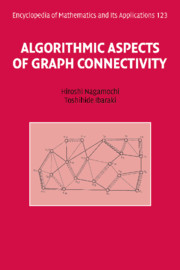Book contents
- Frontmatter
- Contents
- Preface
- Notation
- 1 Introduction
- 2 Maximum Adjacency Ordering and Forest Decompositions
- 3 Minimum Cuts
- 4 Cut Enumeration
- 5 Cactus Representations
- 6 Extreme Vertex Sets
- 7 Edge Splitting
- 8 Connectivity Augmentation
- 9 Source Location Problems
- 10 Submodular and Posimodular Set Functions
- Bibliography
- Index
3 - Minimum Cuts
Published online by Cambridge University Press: 07 May 2010
- Frontmatter
- Contents
- Preface
- Notation
- 1 Introduction
- 2 Maximum Adjacency Ordering and Forest Decompositions
- 3 Minimum Cuts
- 4 Cut Enumeration
- 5 Cactus Representations
- 6 Extreme Vertex Sets
- 7 Edge Splitting
- 8 Connectivity Augmentation
- 9 Source Location Problems
- 10 Submodular and Posimodular Set Functions
- Bibliography
- Index
Summary
In this chapter we show, as applications of maximum adjacency (MA) ordering, that a minimum cut in an edge-weighted graph can be found efficiently and that a maximum flow between certain vertices, called a pendent pair, can be computed efficiently.
There are various applications of minimum cut algorithms such as cutting plane algorithms [8, 47, 199], the traveling salesman problem (TSP) [164, 219, 311], the vehicle routing problem [15, 280], network reliability theory [176, 292, 281], large-scale circuit placement [31, 46, 114, 210], information retrieval [28], image segmentation [102], automatic graph drawing [218], compilers for parallel languages [34], and computational biology [115, 116, 124, 313].
A standard algorithm to compute a minimum cut in an edge-weighted graph G = (ν, ε) was to solve n – 1 (s, t)-maximum flow problems by changing the source sink pair (s, t) over all t ∈ ν – s, where s was fixed to an arbitrary vertex in ν. Using an O(nm log(n2/m)) time maximum flow algorithm [103] yields an O(n2m log(n2/m)) time algorithm for computing a minimum cut in G.
In Section 3.1, we show that the last two vertices in an MA ordering is a pendent pair; that is, the local edge-connectivity between them is equal to the degree of the last vertex. Using this property, in Section 3.2 we give a novel algorithm for computing a minimum cut in a graph, which runs in O(mn + n2 log n) time. Section 3.3 deals with an application of the minimum-cut algorithm. In Section 3.4, we derive a hierarchical structure of MA orderings, and in Section 3.5 we see that a maximum flow between a pendent pair can be constructed in linear time.
- Type
- Chapter
- Information
- Algorithmic Aspects of Graph Connectivity , pp. 114 - 136Publisher: Cambridge University PressPrint publication year: 2008

